Fiber Bragg Grating Pulse and Systolic Blood Pressure Measurement System Based on Mach–Zehnder Interferometer
Abstract
1. Introduction
2. Principle of the System
2.1. Principle of Optical Path Design
2.2. Principle of Circuit Design
3. Experiment and Discussion
3.1. Pulse Measurement
3.2. SBP Measurement
4. Conclusions
Author Contributions
Funding
Institutional Review Board Statement
Informed Consent Statement
Data Availability Statement
Conflicts of Interest
References
- Huynh, T.H.; Jafari, R.; Chung, W.-Y. Noninvasive Cuffless Blood Pressure Estimation Using Pulse Transit Time and Impedance Plethysmography. IEEE Trans. Biomed. Eng. 2019, 66, 967–976. [Google Scholar] [CrossRef] [PubMed]
- Liu, Z.; Xiao, L.; Liu, Y.; Gao, L.; Zhang, J.; Si, W. Symmetrical Photoplethysmogram Signal-Based Cuff-Less Blood Pressure Estimation. IEEE Sens. J. 2024, 24, 8902–8911. [Google Scholar] [CrossRef]
- Xing, X.; Sun, M. Optical blood pressure estimation with photoplethysmography and FFT-based neural networks. Biomed. Opt. Express 2016, 7, 3007–3020. [Google Scholar] [CrossRef]
- Karimpour, P.; May, J.M.; Kyriacou, P.A. Photoplethysmography for the Assessment of Arterial Stiffness. Sensors 2023, 23, 9882. [Google Scholar] [CrossRef]
- Shu, Q.; Wu, L.; Lu, S.; Xiao, W. High-sensitivity structure based on fiber Bragg grating sensor and its application in nonintrusive detection of pipeline pressure change. Measurement 2022, 189, 110444. [Google Scholar] [CrossRef]
- Poh, A.H.; Hassan, M.R.A.; Bakar, M.H.A.; Adikan, F.R.M.; Moghavvemi, M. Profile Morphology of Fiber Bragg Gratings During Initial Cracking: A Case Study on Proof Load Testing of an Arch Spandrel Segment. IEEE Sens. J. 2022, 22, 5678–5687. [Google Scholar] [CrossRef]
- Xu, D.; Feng, D.; Chen, Q.; Huo, D.; Qiao, X. Compact-Packaged and Diaphragm-Lever Structured Fiber-Optic Temperature and Pressure Sensors for Oil and Gas Well Applications. IEEE Sens. J. 2022, 22, 22670–22677. [Google Scholar] [CrossRef]
- Zhu, S.; Liu, M.; Song, H.; Li, C.; Yang, X.; Chen, X. An integrated Dual-Parameter sensor based on FBG for Temperature/Pressure monitoring of fluid pipeline. Opt. Fiber Technol. 2024, 84, 103694. [Google Scholar] [CrossRef]
- Talebi, V.; Soofi, H. Distributed strain sensing, employing apodized π-phase shifted FBG: Application in power transformer oil breakdown detection. Optik 2022, 268, 169781. [Google Scholar] [CrossRef]
- Luo, J.; Hao, Y.; Ye, Q.; Hao, Y.; Li, L. Development of Optical Fiber Sensors Based on Brillouin Scattering and FBG for On-Line Monitoring in Overhead Transmission Lines. J. Light. Technol. 2013, 31, 1559–1565. [Google Scholar] [CrossRef]
- Mohammed, A.; Hu, B.; Hu, Z.; Djurovic, S.; Ran, L.; Barnes, M.; Mawby, P.A. Distributed Thermal Monitoring of Wind Turbine Power Electronic Modules Using FBG Sensing Technology. IEEE Sens. J. 2020, 20, 9886–9894. [Google Scholar] [CrossRef]
- Xiao, K.; Wang, Z.; Ye, Y.; Teng, C.; Min, R. PDMS-embedded wearable FBG sensors for gesture recognition and communication assistance. Biomed. Opt. Express 2024, 15, 1892–1909. [Google Scholar] [CrossRef] [PubMed]
- Shi, C.; Zhang, H.; Ni, X.; Wang, K. An FBG-Based Sensor With Both Wearable and Handheld Forms for Carotid Arterial Pulse Waveform Measurement. IEEE Trans. Instrum. Meas. 2023, 72, 7506610. [Google Scholar] [CrossRef]
- Park, D.Y.; Joe, D.J.; Kim, D.H.; Park, H.; Han, J.H.; Jeong, C.K.; Park, H.; Park, J.G.; Joung, B.; Lee, K.J. Self-Powered Real-Time Arterial Pulse Monitoring Using Ultrathin Epidermal Piezoelectric Sensors. Adv. Mater. 2017, 29, 1702308. [Google Scholar] [CrossRef]
- Díaz, C.A.R.; Marques, C.A.F.; Domingues, M.F.F.; Ribeiro, M.R.N.; Frizera-Neto, A.; Pontes, M.J.; André, P.S.; Antunes, P.F.C. A cost-effective edge-filter based FBG interrogator using catastrophic fuse effect micro-cavity interferometers. Measurement 2018, 124, 486–493. [Google Scholar] [CrossRef]
- Jia, D.G.; Chao, J.; Li, S.; Zhang, H.X.; Yan, Y.Z.; Liu, T.G.; Sun, Y. A Fiber Bragg Grating Sensor for Radial Artery Pulse Waveform Measurement. IEEE Trans. Biomed. Eng. 2018, 65, 839–846. [Google Scholar] [CrossRef]
- Haseda, Y.; Bonefacino, J.; Tam, H.-Y.; Chino, S.; Koyama, S.; Ishizawa, H. Measurement of Pulse Wave Signals and Blood Pressure by a Plastic Optical Fiber FBG Sensor. Sensors 2019, 19, 5088. [Google Scholar] [CrossRef]
- Tang, Z.X.; Wang, S.X.; Shi, C.Y. Development of a Hybrid Force-Displacement Sensor Based on Fiber Bragg Grating for Radial Artery Pulse Waveform Measurement. IEEE Sens. J. 2021, 21, 20045–20054. [Google Scholar] [CrossRef]
- Kumar, N.V.; Pant, S.; Sridhar, S.; Marulasiddappa, V.; Srivatzen, S.; Asokan, S. Fiber Bragg Grating-Based Pulse Monitoring Device for Real-Time Non-Invasive Blood Pressure Measurement—A Feasibility Study. IEEE Sens. J. 2021, 21, 9179–9185. [Google Scholar] [CrossRef]
- Rao, Y.-J. In-fibre Bragg grating sensors. Meas. Sci. Technol. 1997, 8, 355–375. [Google Scholar] [CrossRef]
- Oton, C.J.; Tozzetti, L.; Pasquale, F.D. High-Speed FBG Interrogation With Electro-Optically Tunable Sagnac Loops. J. Light. Technol. 2020, 38, 4513–4519. [Google Scholar] [CrossRef]
- Zhou, B.; Guan, Z.G.; Yan, C.S.; He, S.L. Interrogation technique for a fiber Bragg grating sensing array based on a Sagnac interferometer and an acousto-optic modulator. Opt. Lett. 2008, 33, 2485–2487. [Google Scholar] [CrossRef]
- Ren, N.K.; Yu, Y.L.; Jiang, X.; Li, Y.J. Improved Multi-Grating Filtering Demodulation Method Based on Cascading Neural Networks for Fiber Bragg Grating Sensor. J. Light. Technol. 2019, 37, 2147–2154. [Google Scholar] [CrossRef]
- Dong, X.Y.; Shao, L.Y.; Fu, H.Y.; Tam, H.Y.; Lu, C. Intensity-modulated fiber Bragg grating sensor system based on radio-frequency signal measurement. Opt. Lett. 2008, 33, 482–484. [Google Scholar] [CrossRef]
- Gautam, A.; Kumar, A.; Kinjalk, K.; Thangaraj, J.; Priye, V. A Low Cost FBG Based Online Weight Monitoring System. IEEE Sens. J. 2020, 20, 4207–4214. [Google Scholar] [CrossRef]
- Wang, F.; Liu, Z.; Wang, X.; Ma, T.; Yu, K.; Zhao, X.; Liu, Y. Cascade Edge Filter for Demodulation of Quasi-Distributed FBG Sensor. IEEE Sens. J. 2022, 22, 23952–23959. [Google Scholar] [CrossRef]
- Zhang, X.; Niu, H.; Hou, C.; Di, F. An edge-filter FBG interrogation approach based on tunable Fabry-Perot filter for strain measurement of planetary gearbox. Opt. Fiber Technol. 2020, 60, 102379. [Google Scholar] [CrossRef]
- Zhu, X.; Jiang, C.; Guo, X.; Chen, H.; Sun, S.; Liu, C. High-sensitivity temperature sensor based on Mach–Zehnder interferometer filled with dimethyl silicone oil. Meas. Sci. Technol. 2022, 34, 015111. [Google Scholar] [CrossRef]
- Zhou, R.; Gao, H.; Feng, Z.; Qiao, X. Simulation and hardware implementation of demodulation for fiber optic seismic sensor with linear edge filtering method. Opt. Fiber Technol. 2020, 60, 102384. [Google Scholar] [CrossRef]
- Díaz, C.; Leitão, C.; Marques, C.; Domingues, M.; Alberto, N.; Pontes, M.; Frizera, A.; Ribeiro, M.; André, P.; Antunes, P. Low-Cost Interrogation Technique for Dynamic Measurements with FBG-Based Devices. Sensors 2017, 17, 2414. [Google Scholar] [CrossRef]
- Li, N.; Yu, J.; Hu, H.; Mao, X.; Zhao, Y.; Huang, L. The Correlation Study of Cun, Guan and Chi Position Based on Wrist Pulse Characteristics. IEEE Access 2021, 9, 28917–28929. [Google Scholar] [CrossRef]
- Chen, W.; Kobayashi, T.; Ichikawa, S.; Takeuchi, Y.; Togawa, T. Continuous estimation of systolic blood pressure using the pulse arrival time and intermittent calibration. Med. Biol. Eng. Comput. 2000, 38, 569–574. [Google Scholar] [CrossRef] [PubMed]

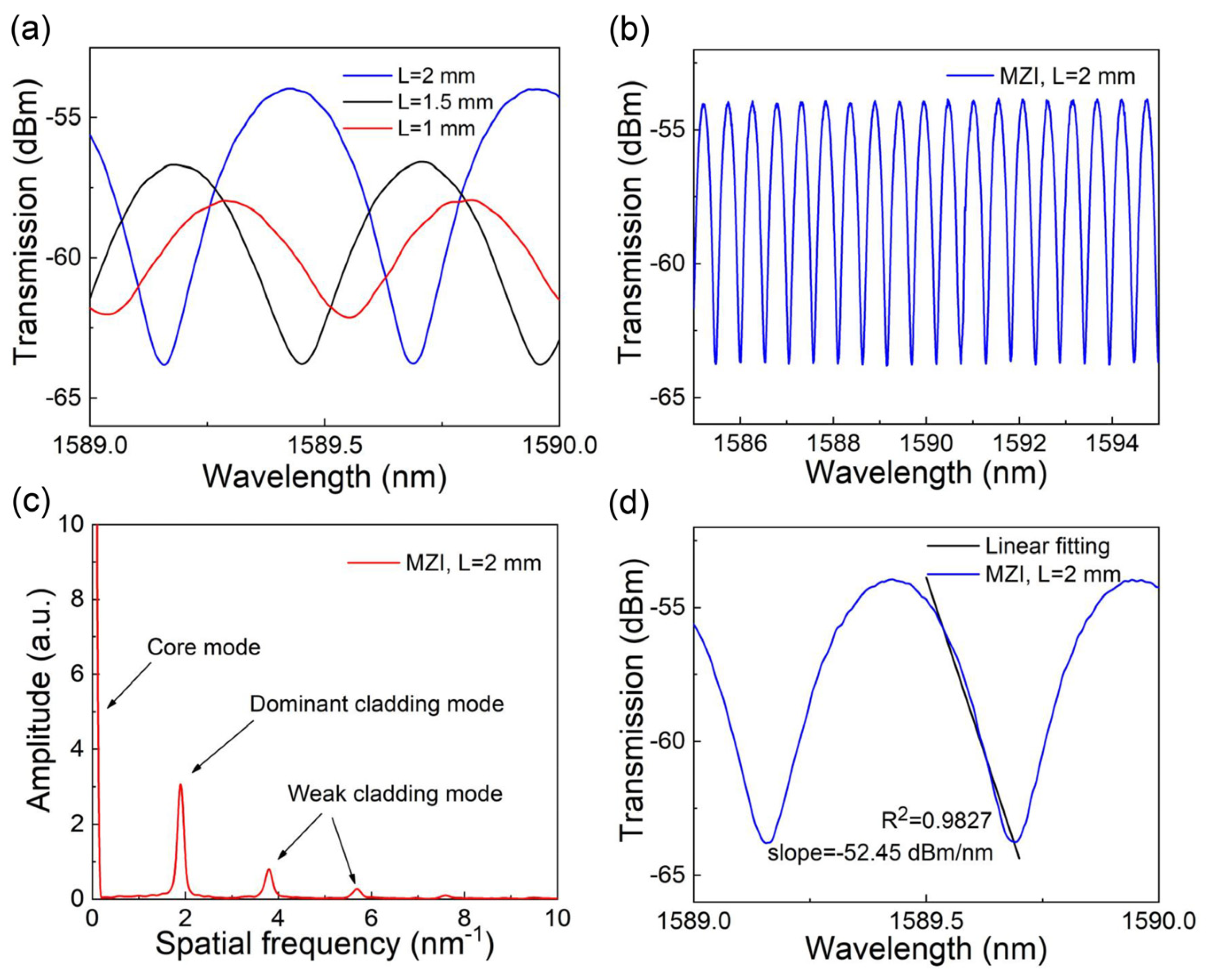
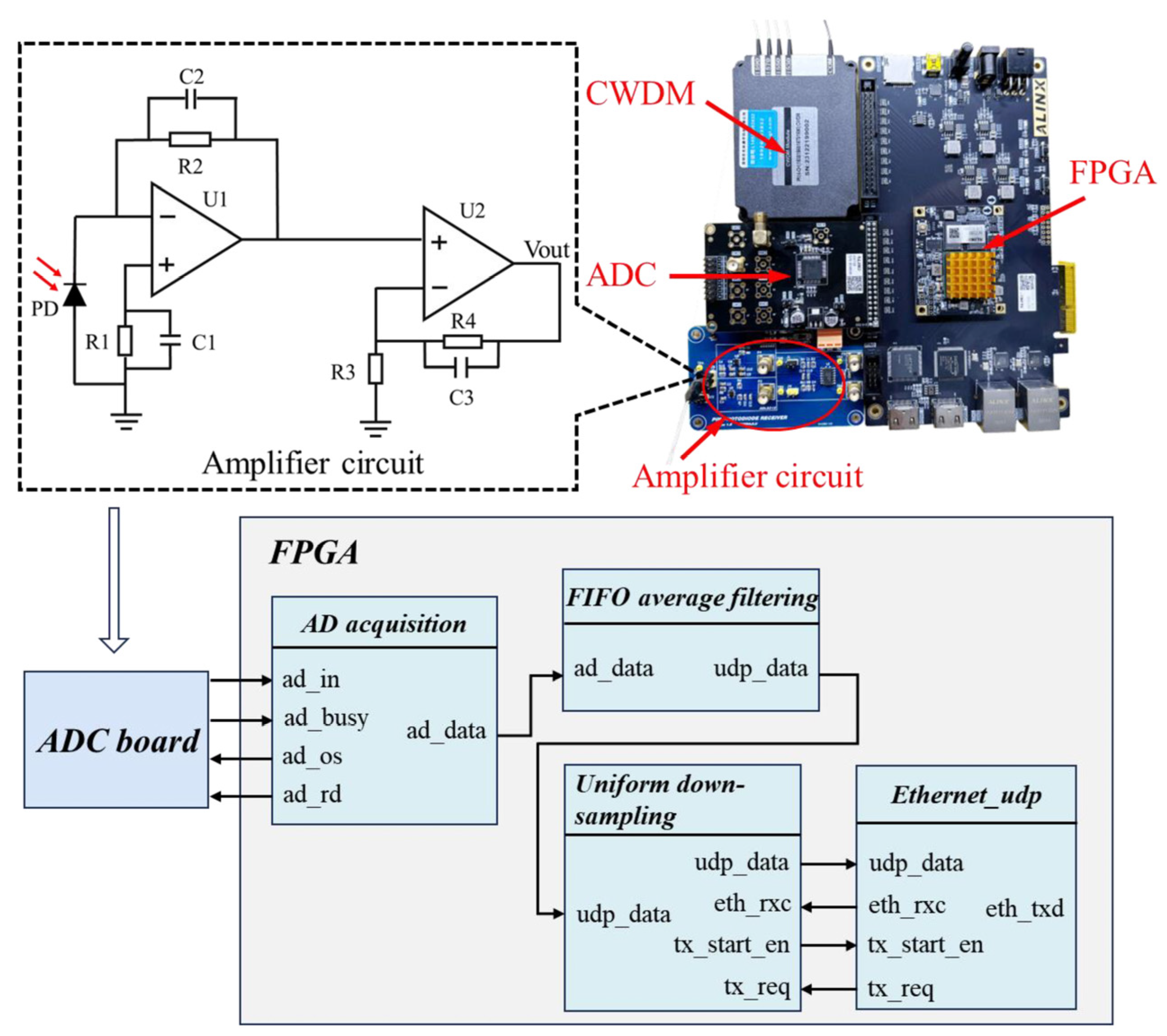

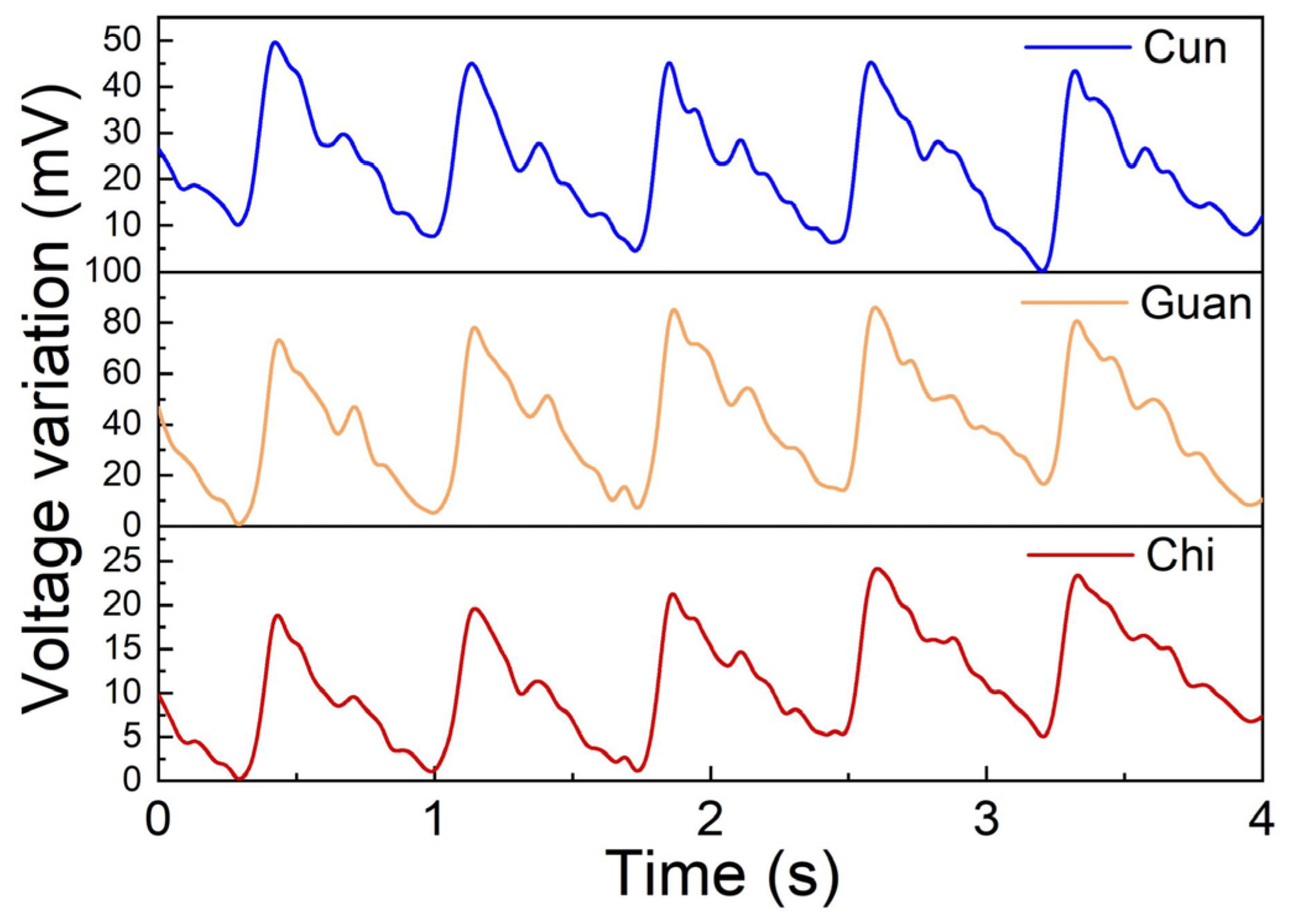
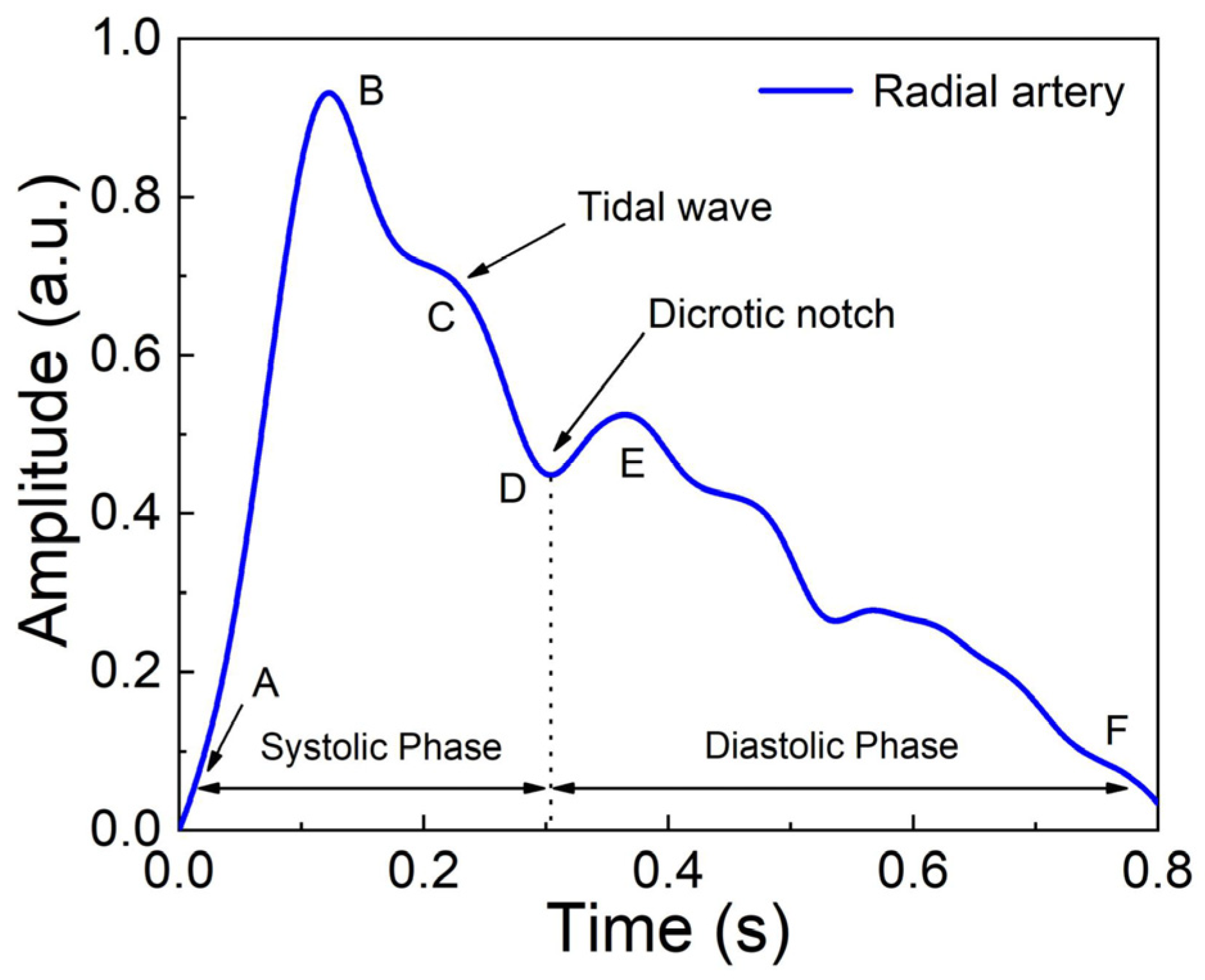

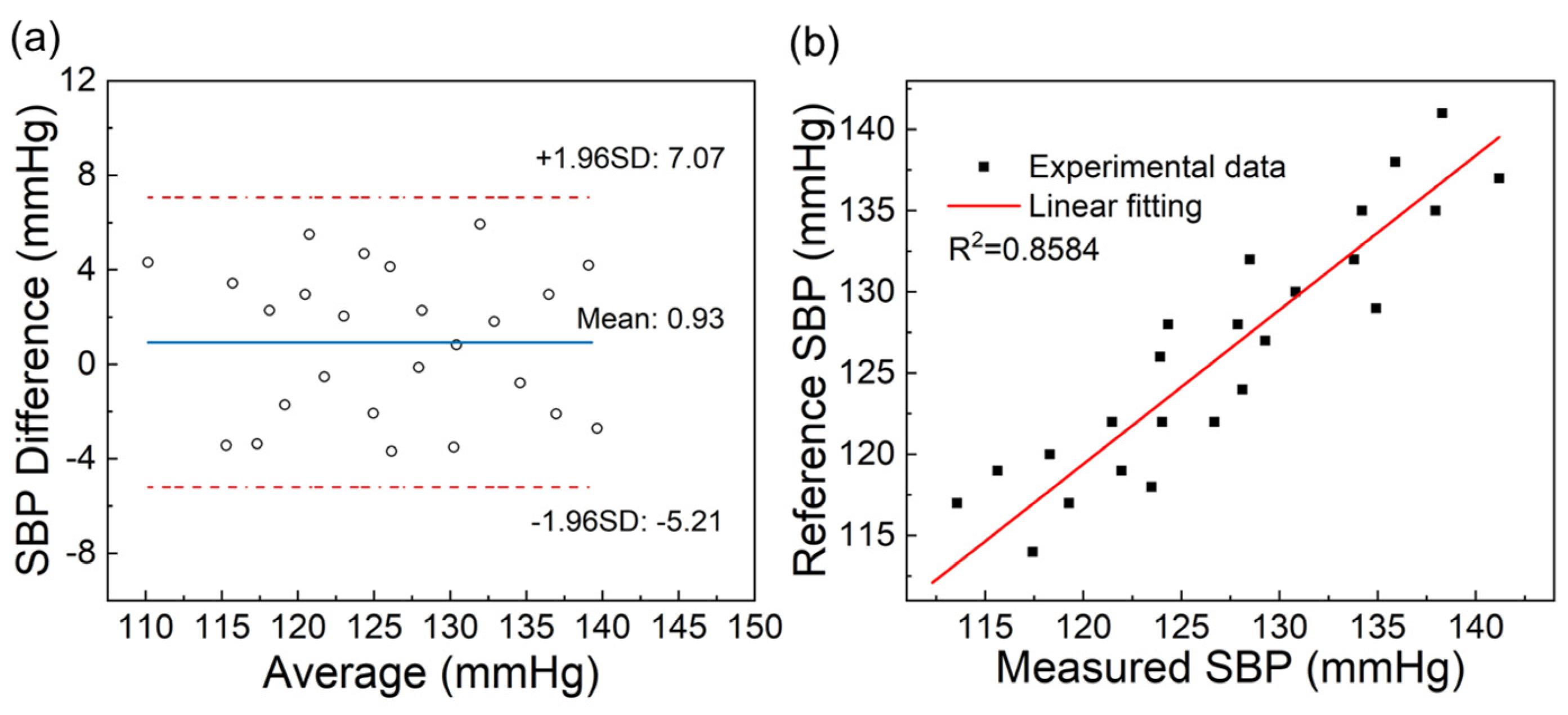
Disclaimer/Publisher’s Note: The statements, opinions and data contained in all publications are solely those of the individual author(s) and contributor(s) and not of MDPI and/or the editor(s). MDPI and/or the editor(s) disclaim responsibility for any injury to people or property resulting from any ideas, methods, instructions or products referred to in the content. |
© 2024 by the authors. Licensee MDPI, Basel, Switzerland. This article is an open access article distributed under the terms and conditions of the Creative Commons Attribution (CC BY) license (https://creativecommons.org/licenses/by/4.0/).
Share and Cite
Li, Y.; Wang, B.; Liu, S.; Gao, M.; Li, Q.; Chen, C.; Guo, Q.; Yu, Y. Fiber Bragg Grating Pulse and Systolic Blood Pressure Measurement System Based on Mach–Zehnder Interferometer. Sensors 2024, 24, 6222. https://doi.org/10.3390/s24196222
Li Y, Wang B, Liu S, Gao M, Li Q, Chen C, Guo Q, Yu Y. Fiber Bragg Grating Pulse and Systolic Blood Pressure Measurement System Based on Mach–Zehnder Interferometer. Sensors. 2024; 24(19):6222. https://doi.org/10.3390/s24196222
Chicago/Turabian StyleLi, Yuanjun, Bo Wang, Shanren Liu, Mengmeng Gao, Qianhua Li, Chao Chen, Qi Guo, and Yongsen Yu. 2024. "Fiber Bragg Grating Pulse and Systolic Blood Pressure Measurement System Based on Mach–Zehnder Interferometer" Sensors 24, no. 19: 6222. https://doi.org/10.3390/s24196222
APA StyleLi, Y., Wang, B., Liu, S., Gao, M., Li, Q., Chen, C., Guo, Q., & Yu, Y. (2024). Fiber Bragg Grating Pulse and Systolic Blood Pressure Measurement System Based on Mach–Zehnder Interferometer. Sensors, 24(19), 6222. https://doi.org/10.3390/s24196222







